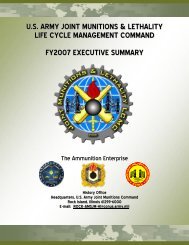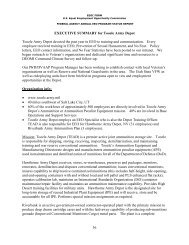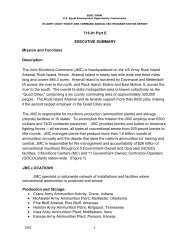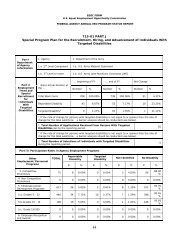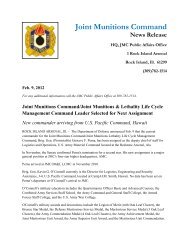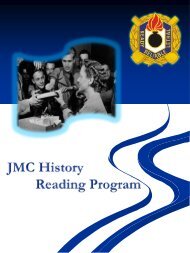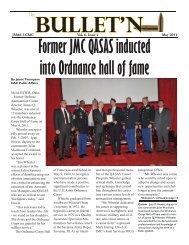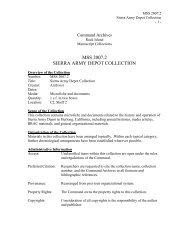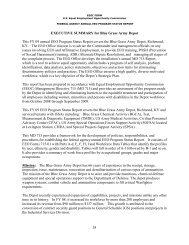History of the Ammunition Industrial Base - JMC - U.S. Army
History of the Ammunition Industrial Base - JMC - U.S. Army
History of the Ammunition Industrial Base - JMC - U.S. Army
Create successful ePaper yourself
Turn your PDF publications into a flip-book with our unique Google optimized e-Paper software.
Small Caliber <strong>Ammunition</strong><br />
The JM&L LCMC increased production in areas needed despite reduced infrastructure<br />
<strong>of</strong> <strong>the</strong> base and reports several success stories. In 2001, Lake City AAP (LCAAP) was <strong>the</strong> sole<br />
government-owned contractor-operated small caliber ammunition production capability in <strong>the</strong><br />
industrial base. The operating contractor, Alliant Techsystems, ATK met <strong>the</strong> challenges <strong>of</strong><br />
completing stringent requirements in response to urgent wartime demands. After September<br />
11 th , 2001, requirements surged to support training and OEF. As troops began <strong>the</strong>ir deployment<br />
to Southwest Asia (SWA) and o<strong>the</strong>r areas around <strong>the</strong> world, <strong>the</strong> requirement for additional,<br />
immediate use small caliber ammunition increased tremendously. Lake City was awarded $19.2<br />
million in Defense Emergency Relief Funds (DERF) to increase Total Plant Volume (TPV)<br />
capacity from 800 million to 1.2 billion rounds a year for contract life; and to accelerate delivery,<br />
provide additional plant capacity for links, and o<strong>the</strong>r quality improvements. LCAAP shipped<br />
over 58 million cartridges in direct support <strong>of</strong> Operation Iraqi Freedom (OIF) in <strong>the</strong> early weeks<br />
and months <strong>of</strong> <strong>the</strong> conflict.<br />
In FY03 LCAAP continued its ramp-up <strong>of</strong> small caliber ammunition for all <strong>the</strong> military<br />
services and produced over 600 million rounds. Because <strong>JMC</strong> still encountered stockpile<br />
shortages for items critical to combat operations, several second source or urgent buys were<br />
completed in FY04. In addition to procuring 1.2 billion rounds from LCAAP valued at $354<br />
million, <strong>JMC</strong> also conducted ten urgency procurements to buy 312 million small caliber<br />
ammunition rounds from suppliers around <strong>the</strong> globe. In order to address <strong>the</strong> shortfall, <strong>JMC</strong> also<br />
invested $28.8 million into LCAAP modernization to fur<strong>the</strong>r improve and increase its<br />
capabilities.<br />
By FY05, <strong>JMC</strong> managed <strong>the</strong> production and delivery schedule for 1.34 billion rounds <strong>of</strong><br />
ammunition produced by LCAAP, valued at over $487 million. <strong>JMC</strong> also awarded contracts<br />
were awarded for production <strong>of</strong> 300 million rounds <strong>of</strong> small caliber ammunition to General<br />
Dynamics Ordnance Tactical Systems (GDOTS) as its second source supplier. Urgent buy<br />
contracts were awarded to Israeli Military Industries for 70 million rounds <strong>of</strong> 5.56mm M855 ball<br />
and 31.4 million rounds <strong>of</strong> 7.62mm blank; and to Olin Winchester for 70 million rounds <strong>of</strong><br />
5.56mm M855 Ball. Fur<strong>the</strong>r actions to mitigate <strong>the</strong> urgency, included <strong>the</strong> procurement <strong>of</strong> 79<br />
million rounds <strong>of</strong> 5.56mm and 41 million rounds <strong>of</strong> 7.62mm from <strong>the</strong> United Kingdom. In total,<br />
215 million rounds were procured as urgent buys in FY05. O<strong>the</strong>r methods <strong>of</strong> increasing <strong>the</strong><br />
small caliber ammunition stockpile included <strong>the</strong> execution <strong>of</strong> maintenance programs for .50<br />
caliber to recapture 10 million rounds <strong>of</strong> A576 (4API/1API Tracer w/M9 Link) from March 2005<br />
through Jan 2007 at Blue Grass <strong>Army</strong> Depot. Rounds were acquired from <strong>the</strong> USAF via crossleveling<br />
and from <strong>the</strong> <strong>Army</strong> demilitarization account. This resulted in <strong>the</strong> successful recovery <strong>of</strong><br />
2.8 million rounds by <strong>the</strong> end <strong>of</strong> September 2005. Aggressive acquisition strategies kept pace<br />
with urgent requirements. In FY08 small caliber production rose to 1.4 billion rounds and<br />
capacity was being increased to 1.6 billion through modernization projects.<br />
TNT<br />
In FY03 significant demand for TNT, used primarily in support <strong>of</strong> USAF general purpose<br />
(GP) bombs, depleted existing inventories <strong>of</strong> TNT at an unanticipated rate. This required <strong>the</strong><br />
development <strong>of</strong> an acquisition strategy for this critical item. <strong>History</strong> showed that Radford and<br />
Holston <strong>Army</strong> <strong>Ammunition</strong> Plants had been filling TNT requirements from <strong>the</strong> SMCA stockpile<br />
62



